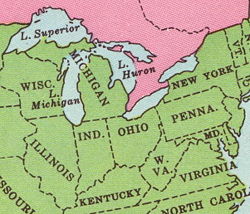Ohio (U.S. state)
Ohio, nicknamed the Buckeye State, was the 17th state admitted to the United States of America, on March 1, 1803. Ohio is the seventh most populous state in the United States, with a population estimated at 11,478,006 people,[1] while ranking 34th in land area.
Seven presidents were born in Ohio, making it the number two state for presidents, after Virginia. Ohio's state song is Beautiful Ohio, a waltz.
Geography
Ohio is located in the Midwest, bordered by Michigan and Lake Erie to the north, Indiana to the west, Kentucky and West Virginia to the south and east, and Pennsylvania to the east. The Ohio River, edges of which are in the state, is the largest river and forms its southern border.
The capital is Columbus, which is also the most populous city in the state. However, the metropolitan areas of Cleveland and Cincinnati are bigger. Other cities include Dayton, Toledo, Akron, Youngstown, and Canton.
See also
Reference
- ↑ 2006 estimate. State and County Quickfacts, U.S. Census Bureau. Data derived from Population Estimates, Census of Population and Housing, Small Area Income and Poverty Estimates, State and County Housing Unit Estimates, County Business Patterns, Nonemployer Statistics, Economic Census, Survey of Business Owners, Building Permits, Consolidated Federal Funds Report.

